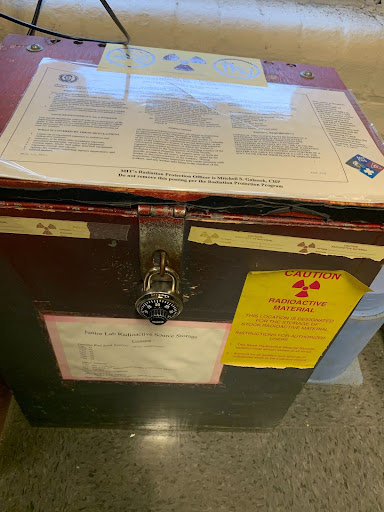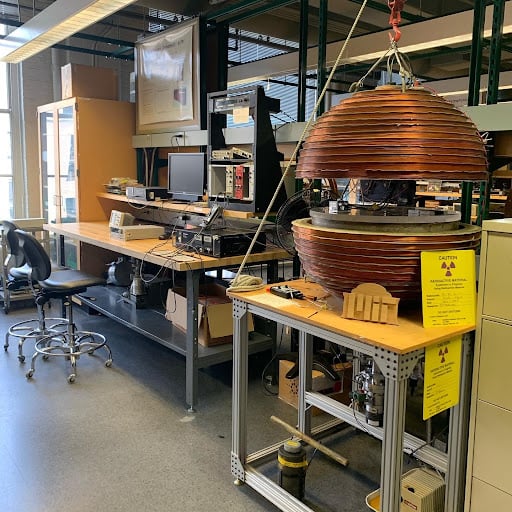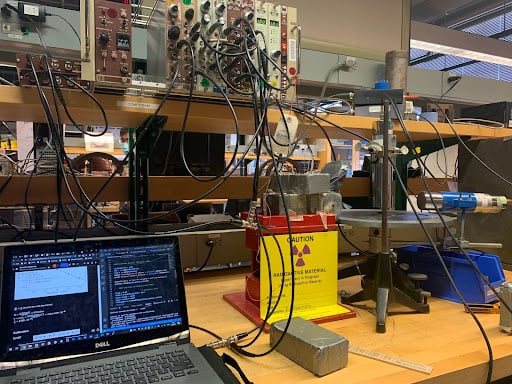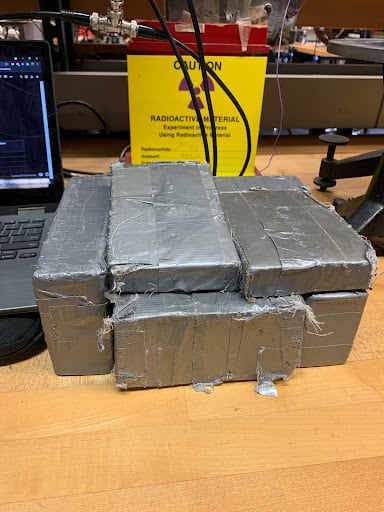
[Guest Post] 8.13 Junior Lab by Cami M. '23
feat. aidan chambers '23
this is a post by my good friend aidan chambers ’23 who is a physics major at mit! this past semester he took 8.13, junior lab!
/////
Junior Lab (8.13) is one of the most infamous, trial-by-fire, taxing, and yet rewarding classes that the Physics department has to offer at MIT. Given the notoriety of the class and its near-universality among Course 8’s I am fairly certain that someone has already given a more insightful and better written look into this class long before I did.
However, since the theme of this class is leading you through Nobel-prize winning experiments that were already done ages ago by people much smarter than you, I think I’m well within my rights to throw my hat into the ring and give my own less than eloquent take on JLab.
So yeah, last fall I took 8.13 (aka Experimental Physics I/Junior Lab/JLab) which was simultaneously the most enjoyable and worst experience I’ve had so far as a Physics major here. While many universities will offer lab courses in addition to your introductory Physics courses right from the start with things like “Physics I + Physics I Lab”, the Physics department at MIT doesn’t follow along this path but instead introduce your actual lab education in a two-semester experimental Physics sequence that you typically take your Junior year as you’re well into your undergraduate education as a Course 8. While the latter half of the two-semester sequence (8.14/Experimental Physics II) is equally interesting and beneficial to Physics majors, it’s not a strict major requirement unless you’re an 8-Focus so for the majority of students who are doing 8-Flex (explained more here) most Physics students will only experience the first half, which is certainly more than enough to get you acquainted with the world of Experimental Physics.
Every class at MIT has an attached credit system which is meant to estimate the number of hours you’re intended to be devoting to this class on a weekly basis. The majority of MIT classes are 12 units, corresponding to an expected 12 hours of work per week. By contrast 8.13 is an 18 unit class, but I consistently felt that this was a lower bound on the amount of work I was putting in every week into running experiments, analyzing data, and preparing my results. With all of this on the table I want to look at the actual structure of this class and why exactly it results in this mountain of work, as well as the individual experiments I chose throughout the class.
Experiment 0 – Hell Weeks Introductory Sequence
When you first start off in the class, you likely have no idea what you’re doing and have nowhere near the amount of prior experience to begin on experiments with the level of detail you’re expected to for this class. Thankfully the Junior Lab instructors understand this and take the time to give thoughtful and detailed explanations for all of the concepts and material you’ll be using throughout the class… but also you only have three weeks (6 class days) before the big boy experiments begin so get ready because now you have:
- ~23 minor introductory assignments to take care of and be on top of
- A few miniature experiments including experimental poisson statistics (blast a detector with gamma radiation and analyze particles from outer space with Cosmic Watch detectors!), the photoelectric effect (Einstein’s Nobel prize winning experiment!), and the Michelson-Morley interferometer (disprove the existence of aether!)
- Time to pick lab partners
- A pendulum experiment to measure the gravitational acceleration on earth’s surface (the best pendulum designer gets a pendulum as a prize!)
- Crash courses in python, data-fitting, statistics, and what essentially amounts to a condensed intro to data science class
- Radiation safety training
- To set up a dropbox paper account and get ready to log every time you take a measurement, do data analysis, or breathe around an experiment for the next 15 weeks
- Time for you and your partner to sort through the list of experiments and pick which ones to lock yourselves into for the rest of the semester!
- Time to write your first paper and give a presentation on one of your mini experiments
Admittedly, all of these introductory assignments and sequences don’t amount to a large share of your final grade in the class and the introductory paper/presentation don’t affect your overall grade since they’re meant to be purely a learning step in the class. Despite this there is definitely an attitude of “just don’t get left behind” over procedural and patient learning that dominates the early weeks of the course.
Don’t know how to code and make plots in python? You do now.
Don’t know how to fit data to a model? You do now.
Don’t know how what a 𝜒² value is? You do now.
As someone who had basically no statistics knowledge and zero lab experience beforehand I felt incredibly floored by these weeks and the pace of the class made me wonder I wasn’t cut out for the rest of the course, but thankfully these intro weeks are the way that they are so that things are able to calm down as you move into the actual experiments of the class.

The definitely not intimidating JLab radiation locker whose contents include:
- Multiple Gamma Radiation Check Sources (mostly expired)
- [REDACTED]
- An expired Peanut Butter Jar filled with Uraninite (No known association to the expired random hall milk)
Experiment 1 – Relativistic Dynamics
After the intro sequence of JLab, you have 3 major experiments that make up the bulk of your time and grade for the class. At the end of each experiment you’ll have a joint presentation with your partner on your process and results as well as an individual paper similar to a lab report but in the style of an academic paper. Looking back I was very happy with the experiments that my lab partner and I chose, beginning with relativistic dynamics as our first major experiment.

Apparatus and work station for relativistic dynamics
This experiment was a great start for the class as it was relatively (no pun intended) straightforward in its goals. We want to look at things traveling near the speed of light and see how what we observe matches up with our theoretical model from special relativity. I had taken 8.033, our undergrad relativity course, last fall so I felt confident about my knowledge about the relevant theory that this experiment was meant to uphold.
Even if it was the same material, moving from chalkboard to lab was an entirely new challenge that gave insights into a lot of the questions experimentalists have to struggle with that we can gloss over in the classroom.

Diagram of the inside of the apparatus for the experiment
- How are we going to find an object that we can get to near light speeds?
- We can use electrons since their charge and small mass means we accelerate them near the speed of light with reasonable ease.
- How are we actually going to get them to go near the speed of light?
- We can use a Strontium/Yttrium-90 beta radiation source which essentially shoots out a variety of high velocity electrons.
- How are we able to measure the actual speed of the electrons?
- We can use electric and magnetic fields to sort and select electrons that are traveling at specific speeds given our known values of the fields’ strengths.
- How can we measure the kinetic energies of the electrons?
- We can use a PIN diode detector connected to a multi-channel analyzer, where we can use a calibration with a known radiation spectrum to turn the inputs to the multi-channel analyzer into actual energies.
This overall was a poor oversimplification of the process of the experiment, which is laid out in more detail here if you’re curious, but I found it a really interesting insight into how experimental physicists exploit and use their knowledge of physical theory to design and create experiments. Despite a few hiccups, our experiment went through well and unsurprisingly we confirmed that Einstein had a few right ideas when it came to his theory of relativity, with our data conforming well to the predictions from special relativity.

The final plot of our data (the error bars are there I promise, they’re just small)
A surprising result from this experiment though is that with the way our experiment was set up, we were actually able to use our data fits to calculate the mass and charge of the electron to within 1 or 2 standard deviations of the accepted value. While I realize how specific and uninteresting this sounds, it was a very cool realization for me to see the concepts and values that I’d been working with for years appear from the data and experiments that I collected and conducted.
Experiment 2 – Compton Scattering
After two and a half weeks on relativistic dynamics it was time for my partner and I to move onto Compton Scattering as our second experiment. For anyone who’s heard of the experiment from a Chemistry or Physics class this is the same Compton who demonstrated the particle nature of light and won a Nobel prize for it. For anyone else who hasn’t heard the term or it’s been a while since their last physical science class the general concept behind the experiment is this:
- Physicists in the early 20th century realized that the energy of X-rays and other EM radiation decreased as it passed through surfaces and scattered off objects
- Physicists by then knew that the energy of EM radiation was tied to the wavelength of the light, so the scattering must be affecting its wavelength
- Arthur H. Compton sets out to try to understand this phenomena and realizes that the amount of change to the wavelength is related to the scattering angle of the light
- To understand his results, Compton theorizes that light interacts with electrons as if it were a particle with momentum and energy but no mass
- Using this assumption Compton is able to develop a successful model for the wavelength shift as a function of the scattering angle that agrees with his experimental data
- Compton had derived incredible proof for the existence of a “light particle” which we know today as a photon
With all of the history and huge accomplishments behind this it was incredibly cool to try and replicate a Nobel prize worthy experiment but the additional challenges of this lab proved to be much more difficult than the first. Compared to our first experiment, we now had two separate detectors to calibrate and sync with one another as means of properly observing scattering events. I also mentioned earlier how we were required to go through radiation safety training since a large amount of experiments require using or being in the presence of gamma and X-Ray radiation sources. Thankfully, using safety protocols and general common sense all this ambient radiation in the lab doesn’t pose any real threats to your health, but it presents a huge problem when you’re running an experiment meant to isolate and measure one specific radiation source. This gave us plenty of valuable practice with signal isolation and noise reduction, which is definitely every experimentalists’ favorite part of conducting experiments and has never produced any excruciatingly annoying occurrences for anyone in Physics in the history of the field.

In case you wanted to see the amazing wiring that is produced when Physics students LARP as Electrical Engineers in order to set up coincidence gating
In all seriousness though it was an interesting introduction to handling background reduction since there is no perfect method for many experiments to ideally isolate the noise while discarding background events in your detector, leading to a lot of trial and error on our parts to explore with what worked best for our experiment at hand. Despite these new challenges, we were able to get pretty convincing data that agreed with the Compton scattering equation which was a nice result to be able to report on.
Additionally the lab (listed in more detail here) contained a secondary result investigating the cross sections of photon-electron scattering. As a student who’s definitely found an interest in Particle Physics this was right up my alley and I proceeded to spend way too much time working on getting results measuring the differential cross section of Compton scattering. This was a notoriously finicky measurement to take so I was very surprised that my measurements converged on something similar to theoretical predictions, which served as an ego boost that slightly validated all the work I put in trying to work through the nasty Klein-Nishina equation.

The previously mentioned measurement of differential cross scattering that let me pretend I understand how quantum electrodynamics works
Experiment 3 – Cosmic Watch
Remember at the beginning sequence of the class when I talked about the Cosmic Watch muon experiment? That’s okay neither did I, but as a surprise to me (make sure you actually read your class syllabi) these detectors came back to form the basis of everyone’s third experiment. Each lab group was given a pair of Cosmic Watch detectors and basically free reign to design whatever experiment we wished that incorporated the detectors. The detectors are primarily designed for measuring muons that result from cosmic rays, but even with this purpose there are still plenty of example experiments you could measure just with this purpose (see pages 51-75 here). Despite this, I decided I was fascinated enough by the last experiment that I wanted to design a more in-depth gamma ray attenuation experiment. I wanted to measure the dependence of photon-electron cross sections upon the photon energy, which was in theory a fairly simple measurement that would just build upon what I learned during Compton Scattering.
Now there wasn’t anything particularly wrong with me designing my own experiment or using the detectors for something other than muon data, a few of my peers had designed and followed through with interesting original experiments, but everything that seemed possible to go wrong with my gamma ray attenuation experiment did go wrong. The Cosmic Watch detectors are designed with the primary task of measuring muons and eliminating background radiation. This meant when I set out to measure gamma radiation I wasn’t simply using a detector that was bad at measuring gamma rays, but a detector that actively fought me and would intentionally discard gamma ray measurements when it could. To counter this I had to remove the coincidence gating feature that was responsible for most of the noise reduction in the detectors. This then introduced the problem of how to counter all the ambient radiation in the room to which I presented the very scientific solution of encasing my detector in as much lead as possible and hoping for the best.

Bad muon detectors get locked in the lead prison for their crimes
Additionally to explore the energy dependence I sought out to measure I needed several different radiation sources ideally with a single definitive photopeak somewhere between 100 keV-1 MeV. When designing this experiment I noticed that thankfully the handy JLab radiation locker had four good candidates for these requirements which should be good enough for my measurements. It wasn’t until after I started taking measurements that I realized that several of these sources had very short half-lives and were older than I was, meaning they were all but inert by the time I tried to use them in my experiment. This left me to swap out 3 of my original 4 gamma ray sources for what we had available which satisfied none of the ideal properties I was looking for and proceeded to give me several headaches as I tried to pull everything together over the next few days with multiple attempts at inconclusive data analysis.
After about two weeks I was in too deep to switch to another experiment, had no conclusive results from my data, and understood paragraphs worth of information as to why each and every aspect of my experiment was failing me. It was here that I came to terms with an important concept in conducting experiments, not every experiment needs to return conclusive and expected results. This is somewhat disappointing since it’s undoubtedly more fun and gratifying to present on groundbreaking data or affirm the latest theoretical models, but sometimes results in Physics research that fail to do either of these things still prove to be some of the most important results in experimental Physics.
With this I chose to change the direction of my experiment to understanding exactly why certain methods proved inconclusive for the measurement at hand and how these things could’ve been improved in future studies of the same concept. It was a very educating – albeit humbling – experience that made sense to conclude my experiments in the class.

A sign that your measurements are bad is when they’re about as likely to resulted from a random line as from your carefully crafted theoretical model
Conclusions
For the final two weeks of the class you’ll revisit one of the previous experiments you’ve done, refining your results based on comments and what you’ve learned over the course and taking additional measurements if necessary. At the end of the course this experiment becomes the topic of your final presentation, which is open to the public and serves as a nice experience to end off the class as you get to invite your friends and family to listen to you talk about residuals and propagating uncertainties as they pretend to have any interest or idea about what you’re presenting.
Since this entire section of the class is designed to have you being introspective about how you’ve performed on experiments and what you’ve learned throughout the class it made sense that this gave me a lot of time to reflect back on the course and what I learned from 8.13. The first obvious realization I had was that this class was a huge time sink. While 8.05 took similar amounts of effort throughout the semester, the amount of work was certainly definitive in that when you reached the answer or proved the equation on a PSET, your work was done and it was onto the next challenge. By contrast there wasn’t a definitive end to any aspect of JLab beyond the somewhat artificial deadlines that told you to move onto the next lab. You could spend an indefinite amount of time on any experiment further refining measurements, accounting for a greater amount of uncertainties, pioneering better methods at error reduction, doing more precise data analysis, et cetera. This paralleled well with the same lessons I’m learning with actual Physics research in my UROP as I come to understand the challenges of having your results converge ahead of some artificial meeting or presentation date even if there’s always more that can be refined or explored.
The second realization I came to is that after this class I am now interested in being an experimental physicist? This was surprising to me for sure since before this class I was pretty dead set on focusing on theory and I had this less-than-educated view that experimentalists just turned knobs on oscilloscopes and obsessed over two numbers not agreeing to the billionth place. While I’ve confirmed that this is pretty true, I’ve also come to learn that experimental physics is such an interesting field as it requires an underlying basis for so much physical theory and the creativity to know how to exploit these theories to design and create experiments. Even the pretty basic relativistic dynamics experiment I described at the start of this class made such an inventive use of exploiting ideas from electromagnetism and gamma ray spectroscopy to explore ideas in special relativity that it made me gain a much deeper appreciation for all the innovation and creative approaches that must go into a far more detailed experiment like the Large Hadron Collider. This change of direction might also be attributable to the fact that my more theory-heavy class this semester (8.05) severely hurt me and my optimism for a future in theoretical physics, but I’ll also give credit where credit is due to my experience in this class.
Finally I came away from this class with the reaffirmation that this is really what I want to do for the rest of my life. I came into MIT with the idea that I wanted to pursue a PhD and remain in academia, a notion that has certainly been challenged many times throughout my time at MIT, and with this past fall being my most academically challenging semester I’ve taken a more serious approach to exploring what a future career outside of Physics would look like. Despite this I’ve ended this last semester with a greater motivation to continue forwards and explore a future in Physics, as each class I take seems to primarily teach me how little I really know and how much I want to learn about what lies beyond the scope of my knowledge. This class was definitively formative to that as it showed me how gratifying Physics research can be. I once heard a story from my UROP advisor about how he accidentally pulled an all-nighter working through a new dataset that got released right before he was going to bed. While I didn’t understand that at all at the time, I can kind of see where he’s coming from now. Parsing through physical data and getting to extract interesting results literally gave me the same serotonin rushes that I remember getting in my limited experience with green check marks in computer science classes. Additionally, the presentations and papers that we produced throughout the class served as much more tangible representations of the progress and work that I’ve done here than I think most Physics courses offer.
Overall I recognize I have to thank the Junior Lab teaching staff for all the work they’ve put into making this class the challenging and fulfilling experience that it was. If by some miracle you’ve actually read until the end of this post, I hope that you come away with a nice insight into this class and my experience in it. In the chance you’re a Course 8 underclassman planning to take 8.13 in the future, I hope this gives you some greater feeling of excitement for the class apart from the dread that’s far more commonly (and understandably) associated with 8.13.